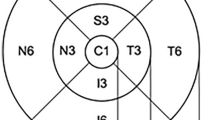Abstract
Background
In phase III trials, the therapeutic efficacy of anti-VEGF therapy with ranibizumab (Lucentis) in patients with choroidal neovascularization due to AMD was demonstrated in a 24-month period with monthly injections. Other studies and models suggested that flexible reinjection regimens can provide similar visual results. The aim of the present study was to evaluate the flexible, predominantly visual acuity-driven ranibizumab retreatment regimen in clinical practice in Germany.
Patients and methods
Best-corrected visual acuity (VA, logMAR) and central retinal thickness (CRT) were recorded initially and every 4–6 weeks during follow-up (mean follow-up 75.5 weeks) from 152 eyes. All eyes were treated initially 3 times with ranibizumab at 4-weekly intervals, and retreated with another three injections if visual acuity decreased and/or CRT increased (>100 μm), and/or if new angiographic leakage and/or new retinal hemorrhages developed. Visual acuity development was analyzed in the whole group. A quartile analysis was also performed, and visual course was correlated with CRT. In all groups, numbers and times of reinjections within the first year were registered and analyzed.
Results
An increase in mean VA of 0.14 (SD 0.22) logMAR could be observed after 3 months, but during follow-up from months 3 to 12 the mean visual acuity decreased again by 0.14 (SD 0.24) logMAR, and was similar to the initial VA despite several reinjections (mean five injections). Stratification of patients according to the visual effect after 3 months (quartile analysis) demonstrated a differentiation of the visual course. Quartile 1, with the largest increase in VA after 3 months and reduction of the retinal edema, lost this positive effect during follow-up (100% of eyes received further injections). In contrast, quartile 2, with a minor increase, and quartile 3 demonstrated a stabilized response during follow-up (80% reinjections), while quartile 4 demonstrated a further loss in VA despite reinjections initially and during follow-up (60% reinjections).
Conclusions
The flexible, predominantly visual acuity-driven ranibizumab retreatment regimen employed in clinical practice in Germany generally resulted in a loss of initially gained VA during 12 months of follow-up. Subgroup analysis showed that this negative effect was especially present in patients with relatively bad VA at treatment entry as well as the highest visual gain. Because this result demonstratse that a visual acuity-related retreatment regimen can not preserve the initial positive treatment effects with ranibizumab in exudative AMD, a revision of this schematic retreatment regimen used in Germany and adaptation to more sensitive retreatment parameters is recommended.


Similar content being viewed by others
References
Brown DM, Kaiser PK, Michels M, Soubrane G, Heier JS, Kim RY, Sy JP, Schneider S (2006) Ranibizumab versus verteporfin for neovascular age-related macular degeneration. New Engl J Med 355:1432–1444
EMEA (2007) Lucentis: Scientific Discussion http://www.ema.europa.eu/humandocs/PDFs/EPAR/lucentis/H-715-en6.pdf. Accessed 16 May 2010
EMEA (2007) Lucentis: Summary of product characteristics http://www.ema.europa.eu/humandocs/PDFs/EPAR/lucentis/emea-combined-h715en.pdf. Accessed 16 May 2010
Fung AE, Lalwani GA, Rosenfeld PJ, Dubovy SR, Michels S, Feuer WJ, Puliafito CA, Davis JL, Flynn HW Jr, Esquiabro M (2007) An optical coherence tomography-guided, variable dosing regimen with intravitreal ranibizumab (Lucentis) for neovascular age-related macular degeneration. Am J Ophthalmol 143:566–583
Holz FG, Korobelnik JF, Lanzetta P, Mitchell P, Schmidt-Erfurth U, Wolf S, Markabi S, Schmidli H, Weichselberger A (2010) The effects of a flexible visual acuity-driven ranibizumab treatment regimen in age-related macular degeneration: outcomes of a drug and disease model. Invest Ophthalmol Vis Sci 51:405–412
Kaiser PK, Blodi BA, Shapiro H, Acharya NR (2007) Angiographic and optical coherence tomographic results of the MARINA study of ranibizumab in neovascular age-related macular degeneration. Ophthalmology 114:1868–1875
Meyer CH, Eter N, Holz FG, SUSTAIN Study Group (2008) Ranibizumab in patients with subfoveal choroidal neovascularization secondary to age-related macular degeneration. Interim results from the SUSTAIN Trial. Invest Ophthalmol Vis Sci 49:273
Regillo CD, Brown DM, Abraham P, Yue H, Ianchulev T, Schneider S, Shams N (2008) Randomized, double-masked, sham-controlled trial of ranibizumab for neovascular age-related macular degeneration: PIER Study year 1. Am J Ophthalmol 145:239–248
Rosenfeld PJ, Brown DM, Heier JS, Boyer DS, Kaiser PK, Chung CY, Kim RY (2006) Ranibizumab for neovascular age-related macular degeneration. New Engl J Med 355:1419–1431
Rothenbuehler SP, Waeber D, Brinkmann CK, Wolf S, Wolf-Schnurrbusch UE (2009) Effects of ranibizumab in patients with subfoveal choroidal neovascularization attributable to age-related macular degeneration. Am J Ophthalmol 147:831–837
Author information
Authors and Affiliations
Corresponding author
Additional information
Financial interest
D. Pauleikhoff: Support of research projects and clinical trials: Novartis, Bayer-Schering, Alcon; consulting, professional fees, travel expenses: Novartis, Pfizer
Rights and permissions
About this article
Cite this article
Heimes, B., Lommatzsch, A., Zeimer, M. et al. Long-term visual course after anti-VEGF therapy for exudative AMD in clinical practice evaluation of the German reinjection scheme. Graefes Arch Clin Exp Ophthalmol 249, 639–644 (2011). https://doi.org/10.1007/s00417-010-1524-5
Received:
Revised:
Accepted:
Published:
Issue Date:
DOI: https://doi.org/10.1007/s00417-010-1524-5




